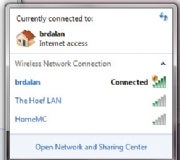Other parts of this story package are dedicated to explaining how to replicate Windows 7 features on a Vista or XP machine--and we offer so many suggestions that you may be starting to think that perhaps there's no compelling reason to upgrade to Windows 7 after all. If so, you should think again. Though Vista and XP users can enjoy some of the new operating system's goodies, either directly or by proxy, various highly desirable features are available only in the genuine article. Here are five that will require you to roll a 7.
skip to main |
skip to sidebar
Popular Posts
-
The Lenovo ThinkPad E220s small business-oriented laptop is powered by a 1.4GHz Intel Core i5-2537M or Core i7-2617M processor, a 12.5-...
-
Thermaltake has just launched a new Massive 23 GT laptop cooler that designed to be used at work, home and on the go and makes the us...
-
Sony VAIO C Series performance and multimedia entertainment laptops, including the 14-inch VAIO CA10 and the 15.5-inch VAIO CB10 . ...
-
Thanko has introduced the PC Waterbed cooling pad for your laptop. The PC Waterbed is a combination cushion and cooling unit for when y...
Categories
- Laptops
- Net book
- Asus
- Lenovo
- Dell
- HP
- Samsung
- Accessories
- Acer
- Msi
- Toshiba
- Laptop Computer Tips
- Laptops Solutions
- Sony VAIo
- Fujitsu
- Gigabyte
- LG
- Eurocom
- Origin
- Panasonic
- Alienware
- Compaq
- Gateway
- MacBook Air
- NEC
- Thermaltake
- Apple
- Download Laptop Drivers
- Evolio
- Foxconn
- Gamma Tech
- Hannspree
- Hercules
- Kobalt
- Maingear
- Packard Bell
- Razer
- Shenzhen
- iBUYPOWER
- thanko
Copyright © 2011 Technology Store | Powered by Blogger








 11:35 am
11:35 am
 Hassaan Syed
Hassaan Syed



 Posted in:
Posted in:
0 comments:
Post a Comment